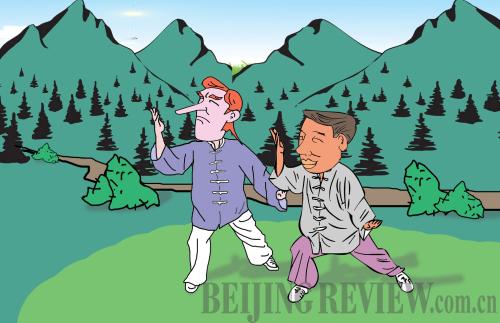|
 |
|
(LI SHIGONG) |
I travelled to Dalian, a coastal city in northeast China's Liaoning Province, on a quest for cultural exchange in 2008. Along the way, I thought I might as well give martial arts a try. Traditional Kung Fu should have been easy to find, right? No. With every word in Chinese, I found myself at the mercy of translators, and fate. With a quick phone call to a school a half-mile walk from my apartment, a Chinese tutor saved me hours of walking around and peering into Chinese shop windows.
My tutor agreed to take me to the gym where I was to meet the man who would teach me. The gym was in the basement of a shopping mall—I would have never found this place alone. When my instructor appeared he spoke only to my tutor. Much was lost in translation. I became more disoriented as the discussion unfolded, so by the end of our meeting the only thing I knew was training would be $3 a session and meetings would be at 1 p.m. on the days I wanted to train. I didn't even learn my new instructor's name.
At my first class, I stood waiting until my instructor gestured toward the padded area, and modeled the "horse stance." Stiff and out of shape, my knees told me they didn't like riding horses, so through the dozens of stances we did that day, I watched the clock, waiting for the hour's ride to end. But my instructor was focused on teaching, not the clock, and he had a lot to teach me. Two hours later, I hobbled out the door.
The next session my legs were so sore, I could barely move. Before practice, I had called my tutor to learn the Chinese words for "sore legs." I pointed at my knees, repeated the words I thought would guarantee me a break. He just smiled and proceeded as if I had said nothing. More horse stance. When my legs weren't bent enough, a lightning fast kick would force me into the right position, or more often, to topple over.
Days later, when I had stayed after practice for language exchange, I finally learned my instructor's name–Zhang Pengbo–but didn't get me out of any work. For weeks, he had me practice Shaolin Seven Star Fist, choreographed routines with dozens of bends, kicks, punches, and jumps done in order. Since I was doing each string of moves alone, I felt like I was learning an aggressive form of ballet rather than a fighting style. After doing each set of moves an innumerable amount of times, I finally found a good rhythm and enough strength to finish my moves without nearly fainting.
One day I came in for practice and found the air so thick with industrial cleaner or glue I could barely breathe. I waved around, clasped my throat, and made a choking noise, said in very broken Chinese, "Zhang, I have to go outside."
He followed me out and I asked if he would practice on a mountain path I had found behind my apartment. He seemed interested, so we hiked to an old training area in the forest. There were makeshift pull-up bars, kick and punch pads, and a stretching area. This began to feel authentic. For months I trained to perfect the most basic of moves with a quiet patience I didn't think I had.
On a whim, I decided last minute to visit the Shaolin Temple to cap off my experience before returning to the United States. At Shaolin, monks answer cellphones and man souvenir booths. The whole place was undergoing a massive construction effort. Tractors and trucks roared around the compound. Nearby age-old pagodas donned concrete patchwork and etchings of modern jumbo jets. I couldn't bear the sight, and left early the next morning.
I told Master Zhang about the encroachment on this legendary place. I had always thought Shaolin would be a hand-hewn stone-wood edifice set against pristine mountains, waving bamboo, and the silence of centuries of devoted meditation. He gave a knowing nod, saying real Kung Fu is learned outside Shaolin. I knew I had been hasty, and should have known that Shaolin was a tourist destination, not where Kung Fu masters actually learn the ancient art.
Nothing came easy in China. Things were never as I thought them to be. But through the challenge came understanding, although much later than I expected. Back in the States, I still practice the Kung Fu I was taught—but more than anything I think back on my friendship with Master Zhang, and realize that is what Kung Fu is about.
The author is an American formerly living in China |
